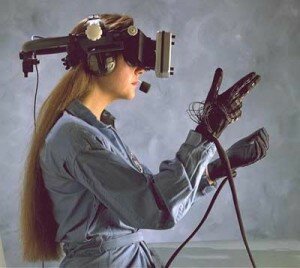The rise of consumer-facing smartphone 3D virtual reality
US based virtual reality expert James Iliff reports on the rise of smartphone virtual reality applications and why VR will be the next frontier in gaming.
Beyond 3D camera rigs, blockbuster movies, and anaglyph glasses, the 3D scene in Los Angeles has a bustling underground, and a revolution is on the horizon. The small but tight-knit virtual reality hardware community is striking out against corporate monoliths like Sony and Vuzix in order to make cutting-edge VR goggles for incredibly cheap prices – and often at much higher quality than their corporate counterparts.
Using Side-by-Side stereoscopic methods and simple optics, these pioneers are bringing VR back into the limelight, ushering forth a new era in the way consumers experience videogames. Potentially, a new artistic medium is emerging altogether.
It all started back in March at the IEEE Virtual Reality Conference, where the Institute for Creative Technologies showcased their latest off-the-shelf virtual system called FOV2GO (an acronym based on "field-of-view" – the common measure of peripheral vision that can be perceived in a given display).

If you own an iPhone, Android, tablet, or any kind of smart device, then you can experience visually immersive VR pretty much anywhere. This is the basic premise of FOV2GO, and it was a runaway hit at IEEE, winning the Best Demo Award and hundreds of kits were given out to conference goers to test out for themselves. The hardware consists of a cheap HMD casing made of laser cut foam core, two aspheric lenses, and a smartphone. Here's a quick video of what it looks like:
This virtual reality kit is not just any old homebrew mod. It provides a high quality immersive experience with high resolution and wide-field of view, something companies like Sony, Vuzix, Sensics, WorldViz, and others struggle to achieve with technology that costs £20,000. How is this possible? Because it just so happens that the smartphone industry, spearheaded by Apple, has rapidly advanced the specific technologies necessary to create inexpensive, accessible, high quality VR headsets. Just to compare, in the 1990’s virtual reality became infamous for expensive HMDs that suffered low resolution, low field-of-view, lousy graphics, and were very clunky to wear. They cost as much as a Mercedes. In the mid 2000’s, armed forces training programs began using refined HMDs, with higher resolution, higher field-of-view, and better graphics – and yet still very clunky, and still the price of a Mercedes. Now with smartphones we can have HMDs that are just as refined (high res, high FOV), and are super light-weight and cost £12 plus the price of a phone!

But what specifically is it about smart devices that make them so exceptional? Two things mainly: the high resolution screens and the built-in gyroscopes. The retina display on the iPhone 4, for instance, provides 960×640 DVGA high resolution on a compact screen. With such high resolution on a tiny screen, we can now construct ultra lightweight VR head-mounted displays. And because the iPhone 4 happens to be only a few hundred pounds, even free on contract, we can accomplish this VR very cheaply. This goes for most smart devices – iPads, Androids, iPod Touch – you name it.
Not only that, but all these smart devices come with gyroscopes! Who would have thought? Gyroscopes can track any kind of orientational data. In other words, when you put an iPhone up to your eyes and use it as a window into a game world (like a first-person shooter), the device will track your head movement so you can look around in real time. No mouse, no D-pads, no analog sticks – just your own natural head movement.
This is the beginning of a fresh, emerging market. The smartphone VR experience is exceptional for its price, and for the time being there aren’t many games created to use it for. At the Maker Faire showcase of FOV2GO in May, we showed off a few apps such as Shayd Mobile and Tales from the Minus Lab, all running in the Unity3D game engine with custom C# scripts to create the side-by-side in-game camera. The most thrilling app was an actual VR game developed by Perry Hoberman, in which you played a film noir detective raiding through offices and breaking into banks in order to uncover a mysterious crime.
The detective game could play on an iPad 3 with very large stereoscopic lenses, allowing for a tasty field-of-view approaching 130 degrees. Considering that the human eyeball sees at around 180 degrees, this was pretty realistic! You start out walking around with a flashlight in a dark office, looking for a light switch. Using other inputs on the iPad, you can click on letters on the desk and read them by the light of dim lanterns, or use your flashlight to get a closer look. Eventually you can pull out your gun and fire bullets! It was a lot of fun, and very immersive in a sensory way.
Right after Maker Faire, the E3 Expo hit Los Angeles with a vengeance, and all of the sudden the VR revolution really caught fire. And this time it went even beyond smartphones, and directly effected the hardcore gaming market.
Palmer Luckey, a pioneering hardware engineer in the field of VR displays, has recently joined forces with the one-and-only John Carmack (co-founder of Id Software, lead programmer of Doom series) to launch Oculus RIFT HMD. I collaborated with Palmer over the past year at the University of Southern California, where I’ve seen numerous iterations of this particular model, several prototypes of which I used on large scale installations. This new iteration was announced by Carmack at E3 last week and got insane coverage from a ton of publications, including Kotaku, IGN, PC Gamer, and the Verge. Check out the OculusVR website for updates. The Kickstarter campaign started on June 14th.
Carmack has agreed to ship a fresh copy of the new Doom 3: BFG Edition along with every RIFT that Palmer gets fundraising for.
Palmer’s RIFT, and the FOV2GO smartphone displays, spark the beginning of new era in virtual reality in which makers, DIYers, and consumers can create and implement cutting edge VR better than large corporations can. Most large VR companies, whether involving head-mounted displays, CAVE projector systems, or haptic feedback, tend to focus on industrial contracts as opposed to consumer usability. As a result the majority of the tech just isn’t built for the games industry.
On the other hand, some companies like Sony and Vuzix are creating consumer HMDs, but they are fundamentally lacking in key elements that make a true VR experience, such as head-tracking and wide FOV. Thus they fall drastically short of expectations, and offer no additional value to current videogames.
Now, for the first time, we can finally integrate robust VR hardware with blockbuster games, and even make our own VR games for mobile devices. Doom 3 is only the beginning. Give it five years, and the marketplace is going to look a whole lot more virtual.
JAMES ILIFF WEBSITE
FREE WEEKLY 3D NEWS BULLETIN –





















Pingback: The rise of consumer-facing smartphone 3D Virtual Reality | Designer 3d Glasses